Numerous gadgets we use every day are powered by embedded systems, the unseen workhorses of our technology. These small computers carry out specific functions reliably and efficiently on a variety of devices, from wearables and smartphones to sophisticated industrial gear and medical equipment. But as technology develops and features get more complex, the requirement for scalable integrated design solutions has grown significantly.
This blog post explores programming strategies that guarantee systems can smoothly adjust to growing needs as it dives into the realm of embedded design solutions. We'll also go over some important things embedded systems developers should keep in mind when creating solutions that will scale in the future.
Examples of Embedded Systems: A Look at Their Wide Range of Uses
Embedded systems are available in a wide range of sizes and forms to suit a multitude of uses. Here are a few well-known instances:
Consumer electronics: touch-screen control, power management, audio processing, and other essential functions are provided by embedded systems in smartphones, smartwatches, fitness trackers, and even game consoles.
Internet of Things (IoT): Embedded systems are used by gadgets like sensor networks, linked appliances, and smart thermostats to gather data, communicate with cloud platforms, and carry out automatic operations.
Industrial Automation: Real-time control, data acquisition, and process optimization are made possible by embedded systems in industrial robots, programmable logic controllers (PLCs), and machine monitoring systems.
Medical Devices: Embedded systems are necessary for the accurate operation and vital functions of insulin pumps, defibrillators, and pacemakers.
These are but a few instances that demonstrate how embedded systems are used extensively across a wide range of sectors. Solutions that can evolve to meet changing demands are becoming more and more necessary as the market for these intelligent devices expands.
Scalability-Aware Programming: Fundamentals for Embedded Design Solutions
Coding must be done carefully if scalable embedded design solutions are to be built. The following are some essential methods that developers can use:
Modular Design: Code reusability and maintainability are enhanced by segmenting the system into smaller, well defined components. Because of this, adding or removing features without affecting the system as a whole is simple for developers.
Memory Management: In embedded systems, memory limitations pose a serious problem. In order to prevent memory leaks and guarantee smooth operation as the system scales, efficient memory allocation and deallocation strategies are essential.
Resource-Constrained Programming: Memory and processor capacity are two common resources that embedded systems must work with. Using programming languages and approaches created especially for these kinds of settings enables effective code execution and the best use of available resources.
Event-Driven Programming: This method improves responsiveness and scalability by enabling the system to respond to events effectively. With event-driven programming, the system waits for pertinent events to initiate additional actions rather than wasting cycles querying for updates all the time.
Data Structures: For scalability and performance, choosing the right data structures for data manipulation and storage is essential. The performance of a system can be greatly improved by selecting architectures that scale effectively with rising data volumes.
Aspects of Scalable Embedded Design Solutions to Take into Account
In addition to particular programming methods, a number of vital factors must be taken into account at the design stage in order to guarantee scalability:
Hardware Selection: It's critical to select the appropriate hardware platform. Choosing a CPU with adequate processing power and memory capacity lays the groundwork for future growth, even though cost may be a determining issue at first. Seek out hardware that has easily upgradeable or replaceable modular components.
Interface Standardization: It is essential to implement standardized interfaces to facilitate communication between various system modules and external devices. This facilitates easier system integration and encourages further system improvements.
Software Architecture That Is Scalable: Creating a software architecture that is scalable guarantees that the system can grow without requiring significant rewrites. This entails planning with modularity, loose component coupling, and clear communication protocols in mind.
Testing and Validation: For any embedded system, rigorous testing and validation are essential. But when it comes to scalability, testing must incorporate scenarios that mimic rising workloads and resource requirements. By being proactive, we can find bottlenecks and improve the architecture for maximum scalability.
In summary
Developing scalable embedded design solutions necessitates a forward-thinking strategy and in-depth knowledge of the intended uses. Through the application of the programming techniques covered above and careful consideration of scalability in the design stage, developers may guarantee that their embedded systems are able to evolve and adapt to an ever-expanding technological environment. Recall that a scalable design leaves room for future innovation and feature development in addition to enabling your embedded system to manage growing workloads.
To Know More About Embedded Design Solutions



















